Glioblastoma is an aggressive form of brain cancer that can be life-threatening and difficult to treat. It affects more than 12,000 people in the United States each year and is the most common malignant tumor in the brain. Knowing the symptoms, treatments, and support available can help those affected by glioblastoma better understand their diagnosis and make informed decisions about their care.
What is Glioblastoma?
According to the Glioblastoma Foundation, glioblastoma is a type of brain tumor that begins in the cells of the brain or spinal cord. It grows quickly and spreads to other areas of the brain or spinal cord. This type of cancer often contains a mixture of cells, some normal and some abnormal. The abnormal cells grow rapidly, forming a mass known as a tumor. Most glioblastomas are grade IV astrocytomas, which means they are malignant.
Symptoms
Penn Medicine says that glioblastoma symptoms can vary greatly depending on where in the brain or spinal cord it has developed. Common symptoms include headaches, nausea, vomiting, seizures, memory loss, poor vision, confusion or changes in behavior or personality, weakness on one side of your body, and difficulty speaking or understanding spoken language (aphasia). Other less common symptoms may include mental health issues such as depression or anxiety.
Treatments
Treatment for glioblastoma usually involves surgery followed by radiation therapy and chemotherapy to kill any remaining cancer cells after surgery. Depending on your specific case, the Mayo Clinic says that you may receive additional treatment options such as immunotherapy (using drugs to stimulate your immune system to fight cancer), target therapies (drugs that target specific proteins in tumors), hormone therapy (to reduce tumor size), or stem cell transplantation (to rebuild damaged tissue). Your doctor will determine what combination of treatments will be best for you based on your individual situation.
Support
Living with glioblastoma can be challenging both mentally and physically. Finding support from family members, friends, healthcare professionals and other individuals living with glioblastoma can provide much-needed comfort during this difficult time. The Glioblastoma Foundation professionals have developed several options for support and resources for patients and their families.




Leave a Reply
You must be logged in to post a comment.